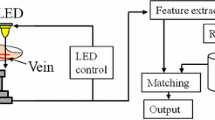Abstract
In this paper, we propose a novel method for finger-vein recognition. We extract the features of the vein patterns for recognition. Then, the minutiae features included bifurcation points and ending points are extracted from these vein patterns. These feature points are used as a geometric representation of the vein patterns shape. Finally, the modified Hausdorff distance algorithm is provided to evaluate the identification ability among all possible relative positions of the vein patterns shape. This algorithm has been widely used for comparing point sets or edge maps since it does not require point correspondence. Experimental results show that these minutiae feature points can be used to perform personal verification tasks as a geometric representation of the vein patterns shape. Furthermore, by this developed method, we can achieve robust image matching under different lighting conditions.
Similar content being viewed by others
References
Barra, V. 2006. Robust segmentation and analysis of DNA microarray spots using an adaptative split and merge algorithm. Computer Methods and Programs in Biomedicine 81, 174–180.
Daugman, J.G. 1993. High confidence visual recognition of persons by a test of statistical independence. IEEE Trans Pattern Analysis and Machine Intelligence 15, 1148–1161.
Dubuisson, M.P., Jain, A.K. 1994. A modified Hausdorff distance for object matching. Proceedings of the 12th IAPR International Conference on Pattern Recognition 1, 566–568.
Gesù, V.D., Starovoitov, V. 1999. Distance-based functions for image comparison. Pattern Recognition Lett 20, 207–214.
Ghafoor, A., Iqbal, R.N., Khan, S. 2003. Robust image matching algorithm. Proceedings of the Fourth EURASIP Conference Focused on Video/Image Processing and Multimedia Communications 6, 155–160.
Gonzalez, R.C. 2005. Digital Image Processing. Publishing House of Electronics Industry, Beijing.
Gualtieri, J.A., Moigne, J.L., Packer, C.V. 1992. Distance between images. Fourth Symposium on the Frontiers of Massively Parallel Computation 10, 216–223.
Guo, B., Lam, K.M., Lin, K.H., Siu, W.C. 2003. Human face recognition based on spatially weighted Hausdorff distance. Pattern Recognition Lett 24, 499–507.
Halici, U., Jain, L.C., Erol, A. 1999. An introduction to fingerprint recognition. In: Jain, L.C., Halici, U., Hayashi, I., Lee, S.B., Tsutsui, S. (Eds.). Intelligent Biometric Techniques in Fingerprint and Face Recognition, CRC Press, Boca Raton, FL, 3–34.
Hawkes, P., Clayden, D.O. 1993. Veincheck research for automatic identification of people. Presented at the Hand and Fingerprint Seminar at NPL9, 230–236.
Hitachi, Ltd. Kawasaki, Kanagawa. 2006. Finger vein authentication technology and its future. Junichi Hashimoto Information & Telecommunication Systems Group, Japan.
Hong, L., Wan, Y.F., Jain, A. 1998. Fingerprint image enhancement: algorithm and performance evaluation. IEEE Transactions on Pattern Analysis and Machine Intelligence 20, 777–778.
Huttenlocher, D.P., Klanderman, G.A., Rucklidge, W.J. 1993. Comparing images using the Hausdorff distance. IEEE Trans Pattern Anal Mach Intell 15, 850–863.
Jain, A., Bolle, R.M., Pankanti, S. 1999. Biometrics: personal identification in networked society. Kluwer Academic Publishers, Dordrecht.
Kang, C.C., Wang, W.J. 2007. A novel edge detection method based on the maximizing objective function. Pattern Recognition 40, 609–618.
Lachance, S., Bauer, R., Warkentin, A. 2004. Application of region growing method to evaluate the surface condition of grinding wheels. International Journal of Machine Tools and Manufacture 44, 823–829.
Lin, K.H., Lam, K.M., Siu, W.C. 2003. Spatially eigen-weighted Hausdorff distances for human face recognition. Pattern Recognition 36, 1827–1834.
Lu, J.M., Yuan, X., Yahagi, T. 2006. A method of face recognition based on fuzzy clustering and parallel neural networks. Signal Processing. 86, 2026–2030.
MacGregor, P., Welford, R. 1991. Veincheck: imaging for security and personnel identification. Adv Imaging 6, 52–56.
Paumard, J. 1997. Robust comparison of binary images. Pattern Recognition Lett 18, 1057–1063.
Perlibakas, V. 2004. Distance measures for PCA-based face recognition. Pattern Recognition Lett 25, 711–724.
Saurel, R., Petitpas, F., Berry, R.A. 2009. Simple and efficient relaxation methods for interfaces separating compressible fluids, cavitating flows and shocks in multiphase mixtures. Journal of Computational Physics 228, 1678–1712.
Sezgin, M., Sankur, B. 2004. Sur-vey over image thresholding techniques and quantitative performance evaluation. Journal of Electronic Imaging 11, 352–356.
Takács, B. 1998. Comparing face images using the modified Hausdorff distance. Pattern Recognition 31, 1873–1881.
Vivek, E.P., Sudha, N. 2006. Gray Hausdorff distance measure for comparing face images. IEEE Transactions on Information, Forensics and Security 1, 342–349.
Vivek, E.P., Sudha, N. 2007. Robust Hausdorff distance measure for face recognition. Pattern Recognition, Elsevier 40, 431–442.
Wanga, L., Leedhamb, G., Choa, D.S.Y. 2007. Minutiae feature analysis for infrared hand vein pattern biometrics. Pattern Recognition Society, Elsevier, 521–524.
You, J., Pissaloux, E., Hellec, J.L., Bonnin, P. 1994. A guided image matching approach using Hausdorff distance with interesting points detection. Proceedings of the IEEE International Conference on Image Processing 1, 968–972.
Zhang, Z.B., Wu, D.Y., Ma, S.L., Ma, J. 2005. Multiscale feature extraction of finger-vein patterns based on wavelet and local interconnection structure neural network neural networks and brain, 2005. International Conference 2, 1081–1084.
Zhang, Z.B., Ma, S.L., Han, X. 2006. Multiscale feature extraction of finger-vein patterns based on curvelets and local interconnection structure neural network. The 18th International Conference on Pattern Recognition 1, 989–993.
Zhu, Z., Tang, M., Lu, H. 2004. A new robust circular Gabor based object matching by using weighted Hausdorff distance. Pattern Recognition Lett 25, 515–523.
Author information
Authors and Affiliations
Corresponding author
Rights and permissions
About this article
Cite this article
Yu, CB., Qin, HF., Cui, YZ. et al. Finger-vein image recognition combining modified Hausdorff distance with minutiae feature matching. Interdiscip Sci Comput Life Sci 1, 280–289 (2009). https://doi.org/10.1007/s12539-009-0046-5
Received:
Revised:
Accepted:
Published:
Issue Date:
DOI: https://doi.org/10.1007/s12539-009-0046-5




